"I should have done this a long time ago! It's not uncommon to hear this reaction when training occasional trainers. How many employees, who excel in their field, are entrusted with in-house training and willingly accept out of curiosity and/or a desire for change? And how many end up becoming discouraged and/or unable to pass on their skills? Experience proves it: they need to be to train effectively and get the results you want. Marion Viennois, a specialist in adult training, explains.

Who are occasional trainers? In-house staff, often experts in their field, who are called upon to pass on their knowledge from time to time. Their role The key to developing skills in companies is undeniable, but their effectiveness depends largely on their preparation upstream and their ability to deliver the training. Training these trainers is essential to guarantee high-quality sessions, tailored to the needs of the learners. Find out why and how to make them even more effective!
What are the needs of occasional trainers?
Two essential needs :
- pass on knowledge effectively
- manage heterogeneity in the group to be trained
1/ Passing on knowledge effectively
Firstly, occasional trainers have need for in-depth teacher training to better pass on their technical skills. And indeed, possessing knowledge does not mean knowing how to pass it on. You have to learn to be a pedagogue, just like you have to build a training programme or set learning objectives. For more information, visit training, not "informationTo do this effectively, you need to know the basics of adult education. Knowing the keys to accessing knowledge, as well as the methods, facilitation techniques and practical tools, changes the whole picture.
Example :
Bruno has been training for 10 years. He knows his training by heart and it always goes well. So he feels at ease in his practices. However, he's curious and wants to update his skills. So he signed up for the Instructor: structuring your training programme properly.
In theory, you might think that he doesn't need this training day. However, it has given new meaning to the training course he leads. First of all, meaning for him. But also, even more meaning for the employees he trains, thanks to the redefinition of the learning objectives. What's more, he has added new tools discovered during training to make it more effective and dynamic. And, of course, he came away with an effective teaching scenario that he is delighted with.
He was even surprised at all the simple changes he was going to be able to make to his training to give it more impact and make it more professional.
2/ Managing the heterogeneity of the group
Secondly, many trainers find difficult to manage heterogeneous groups in terms of knowledge and expectations. Indeed, they are often faced with groups mixing novices and experts. Some are studious, others disinterested... Heterogeneity is indeed multiple in training.
In addition to leadership techniques and pedagogical aspects, it is also essential to learn how to adopt good posture in order to manage the group and its heterogeneity and to maintain dynamism and motivation throughout the course.
This posture can be worked on and learned by training of trainers.
"The training perfectly met my expectations, with very comprehensive content that opens up perspectives for improving my own training practice."
Many trainers train as they have been trained. Others have a natural charisma and expertise that make them fascinating in the eyes of the employees they train. As a result, their training courses are generally appreciated. However, there is a fine line to be drawn between satisfaction and effectiveness... In fact, these training sessions would be much better if these same trainers combined their desire to pass on knowledge, their talent and skills specific to the training activity.
Training occasional trainers: it's a win-win situation
What are the direct benefits? for companies ?
On the one hand, learners are satisfied with their in-house training thanks to the teaching methods used by their training colleague. They retain the new skills all the better!
On the other hand, the trainers are happy and efficient.
But that's not all. A trainer who has been with the company for a long time may feel that this new challenge will give them a boost and help them to break out of their routine. However, this will only be true if they are given the right support and training to ensure that they are not discouraged by this assignment.
A number of companies have noted a better retention of talent by training occasional trainers from among their staff. An invaluable and priceless aspect.
Finally, the skills acquired in teacher training can often be transferred to other professional situations. For example :
- holding a dynamic and participative → meeting thanks to training tools
- presenting a project → in a clear and educational way
- managing relations with other employees → thanks to group management skills
To recap:
| Examples of the benefits to the company of training its trainers | Examples of the benefits of training for occasional trainers |
|---|---|
| Retaining the company's talent | Communicating knowledge effectively |
| Learning culture: employees who enjoy training and being trained | Managing mixed groups Building a coherent and effective training programme |
| Skills that can be transferred to other professional activities (chairing meetings, interpersonal communication, etc.) | Skills that can be transferred to other professional activities (chairing meetings, interpersonal communication, etc.) |
Points to watch for managers
To really benefit from all these very positive aspects, it is essential to bear two things in mind:
Firstly, the occasional trainer has to take time off work to carry out this new task. It is not feasible to ask them to provide training in addition to their usual operational tasks.. This would demotivate them and they would probably end up offering training that was slapdash and therefore less effective. You need to give them time to train and prepare their courses. This will cost money at the outset, but think of it as an investment that will pay for itself after several courses have been given.
Secondly, it's not a good idea to impose this task on an employee who doesn't want it. A good trainer must want to pass on his knowledge. If they don't know how to do it, that's no problem - they'll learn. However, if they don't have a modicum of patience or the desire to share their knowledge, then their training courses will probably not be as effective as they should be. So choose the right candidates for this new task! Good training for trainers will give them the confidence and tools they need to succeed in this new challenge.
2 tips for occasional trainers
Tip 1: Deconstruct your knowledge
The first thing to do to be a good occasional trainer is to deconstructing knowledge to understand the stages involved in acquiring this same knowledge. You are an expert, but you have to understand that what seems obvious to you is not necessarily obvious to the learner.
Best practice:
Build a progressive, coherent and appropriate teaching scenario, and the positive impact will quickly become apparent!
Get trained!
ORSYS one-day training course on unwound educational will get you up and running in no time!
Testimonial :
"I've been doing my training for 10 years now. But this day enabled me to see it completely differently, to give it a new meaning and to improve it considerably thanks to the work I did on the course!
Tip 2: Understand how adults work and learn
The second key is to understand how an adult functions and learns. Neuroscience is clear: it is no longer possible to speak effectively to silent learners who take notes without participating in the construction of their knowledge. This is even less true with the new generation of learners, known as Z.
Best practice:
Discover the benefits of neuroscience and adult education and apply them to your training courses. You'll immediately see the impact on your learners' motivation!
Get trained!
A training ofOccasional trainers over 2 days will answer many of your questions.
Testimonial :
"Relevant and useful training with lots of tools to make the course quickly assimilable."
Occasional trainers: discover these 4 tools to use without moderation!
For the more curious and self-taught among you, take a look at :
Wooclap
Learning apps
The talking wall
The shifting debate
Wooclap and Learning apps
Wooclap and Learning apps allow you to create very simple digital educational content yourself. Learners scan a QR code and find the activity directly on their phone.
Example 1 with Learning apps
An activity that can be done alone or with others: reconstruct the descriptions of each teaching method.
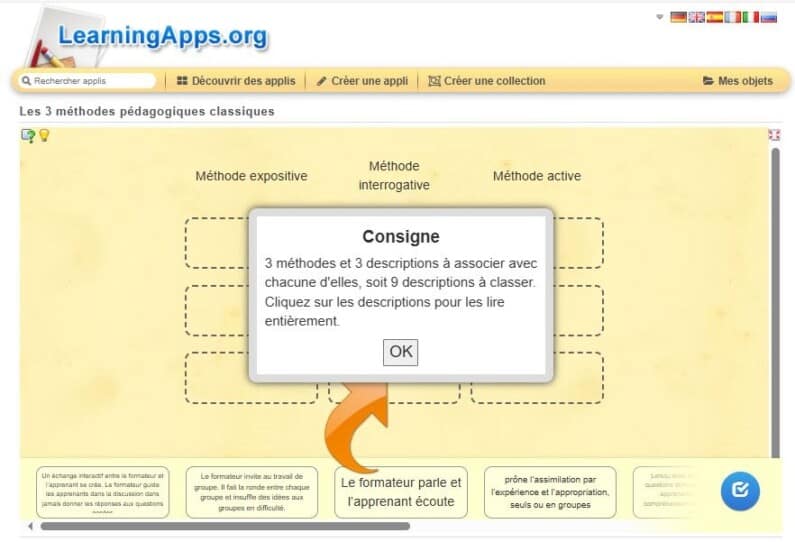
Example 2 with Wooclap
A digital version of the well-known word cloud activity. Each participant can enter as many words as they like, and they all appear simultaneously on the screen.
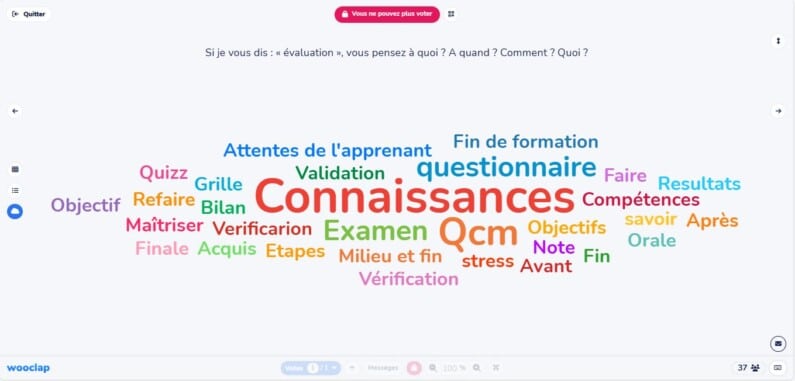
Example 3 with Wooclap
Receive opinions and arguments from employees, who can also like the responses of other participants if they like them. All anonymously, to facilitate the expression of opinions.
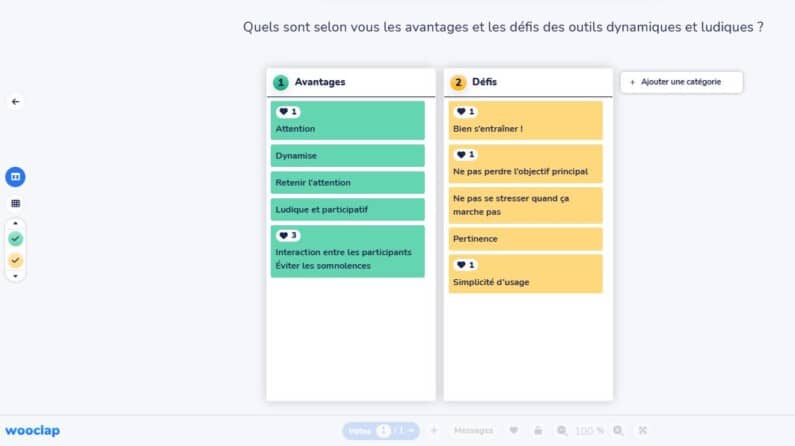
The talking wall and the moving debate
The "talking wall" and "moving debate" techniques can be used to organise activities that are both participative and energising.
Examples of teaching sheets for organising these activities:
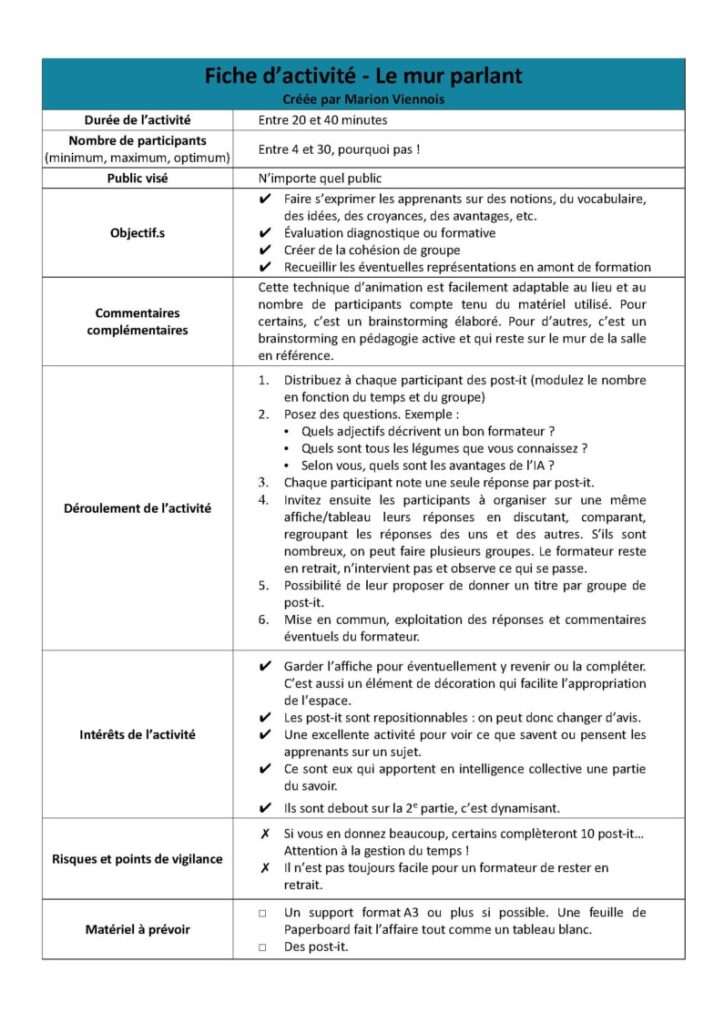
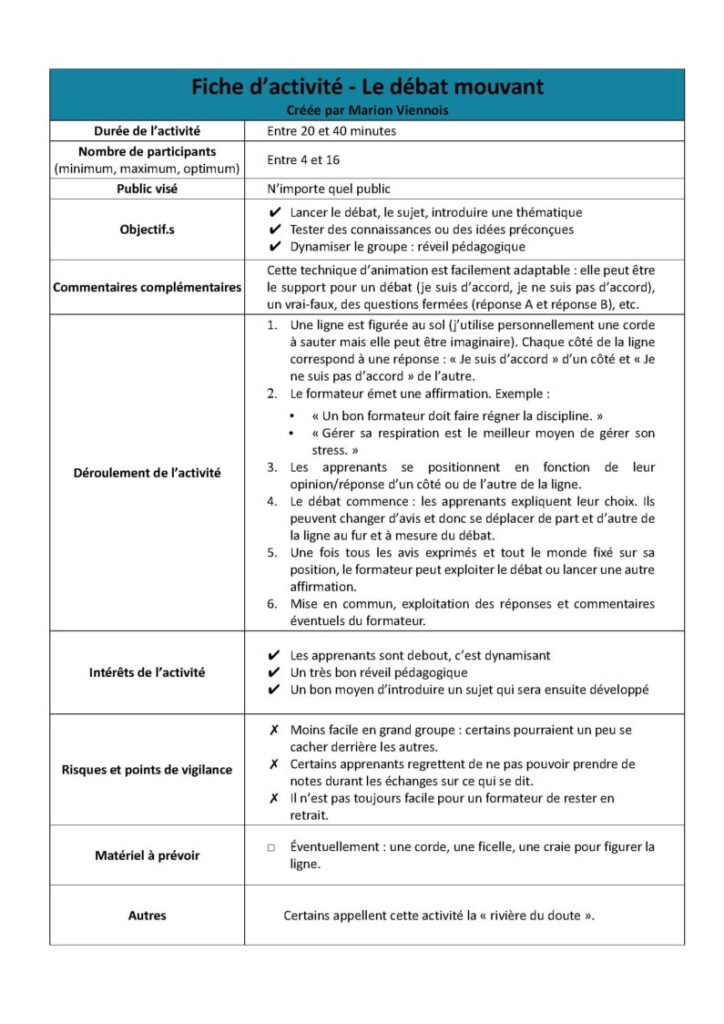
Bonus: these 4 tools are free!
[Expert voice]
"I like to get them experimenting with techniques."
Marion Viennois, trainer
"What I like most about training occasional trainers is that they become learners again for a while. They can then analyse the challenges of a training course even better. I particularly like to get them to experiment with facilitation techniques so that they can experience them for themselves as learners before consciously choosing to implement them in their training courses. We work at 360° because we constantly alternate between times when they are learners and times when they 'become' trainers again and analyse their practice - and mine! - to make progress on their teaching path. It's really exciting!





